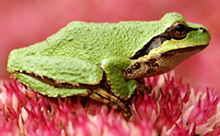The natural ecosystems of Eastern Vancouver Island and the Gulf Islands are unique. They are often an inspiration to artists, poets, writers, photographers, musicians, meditators, bird watchers, tide pool investigators, scientists, hikers, and people of all ages who enjoy and appreciate natural environments. They provide recreational and educational opportunities for everyone. Protecting them means that future generations will be able to observe the amazing natural history of this area.
Ecologically Sensitive Lands

We are fortunate that the Pender Islands still have undeveloped areas that are biologically diverse and provide specialized habitats for some rare, threatened and endangered species. (see B.C. Provincial 2001 Red + Blue Lists) They need your help if they are to remain and flourish. If you visit our parks and trails, walk with invisible feet; take pictures not souvenirs; what you take in, take out: and leave no trace of your stay.
The Sensitive Ecosystems Inventory (SEI) Survey of Eastern Vancouver Island and the Gulf Islands was completed in 1997. The study revealed that at that time, "In the Islands area, only 7.8% of the land base was mapped as sensitive ecosystems with an additional 0.4% of seasonally flooded fields." Lands containing these ecosystems are, therefore, likely to be eligible for a Minister of Environment Certificate indicating that a property qualifies as environmentally sensitive. These properties would be eligible for tax benefits if donated.
The size of the ecologically sensitive zones reported by the SEI to be on the Pender Islands are listed below. The SEI website has detailed information and inspiring pictures of life in these zones.
- 9.2 hectares Woodlands in widely scattered fragments of open canopy, mixed aged trees, snags and seasonal leaf fall.
- 10.6 hectares of Coastal Bluffs that are rocky and dry with nutrient poor soils.
- 13.0 hectares of ecologically sensitive Terrestrial Herbaceous areas where there are wildflower meadows and grassy hill tops with moss covered rocks.
- 71.0 hectares of ecologically sensitive Older Forest lands with confers averaging 100 years of age. Some may be 50 meters high. These are sadly disappearing to logging.
- 23.0 hectares of ecologically sensitive Sparsely Vegetated land consisting mostly of gravel, sand and bedrock on cliffs, bluffs, and spits.
- 119.0 hectares of ecologically sensitive Wetlands with seasonal or year-round water in bogs, marshes, fens, swamps, shallow water and/or wet meadow sites.
- 7.0 hectares of ecologically sensitive Seasonally Flooded Agricultural Fields usually found in valleys with poor drainage and a high water table.
- 654.5 hectares of ecologically sensitive Older Second Growth Forest. Here are found conifers between 60 and 100 years old. Logging is reducing these zones.
- 0 hectares of ecologically sensitive Riparian zone land next to streams and rivers where their dense vegetation provides shade and stability.
Ecologically Sensitive Inter-tidal Areas
When you visit beaches on the Pender Islands, do not remove objects or creatures which are part of the natural environment. Leave the few remaining oysters, clams and mussels to regenerate. Take pictures not souvenirs. Don't wait for the annual "Clean the Beaches Day." Become a friend of the beaches by collecting and discarding or recycling plastic and metal garbage the tide has washed in.
Ecologically Sensitive Ocean Areas
The sea and sea creatures around the Pender Islands are also in need of protection. The Orca Pass International Stewardship initiative seeks to protect the waters around the Southern Gulf Islands in British Columbia and some of the San Juan Islands in Washington State. Other organizations concerned with Marine Protected Areas can be found at Fisheries and Oceans Canada.
Orca Populations Around the Penders
In 1999 Killer Whales, or Orcas, in south coast waters were placed on the threatened species list and may soon be placed on the endangered species list. In 2001, seven whales from L pod died. This is one of 3 pods that frequent the waters around the Penders. The pod is reported to have lost every calf born to it since 1996. This loss brings the overall population of the three southern resident Orca pods down to just 78 individuals, from a high of 99 in 1995 — a 21% loss.
Researchers suggest that the diminishing number of killer whales is due to many factors, including contaminants in the water, decline of salmon, whale watching and the capturing of whales for display during the 60's and 70's. See the
Georgia Strait Alliance or the
Center for Biological Diversity for pictures and more information.
© Image courtesy of Minette Layne